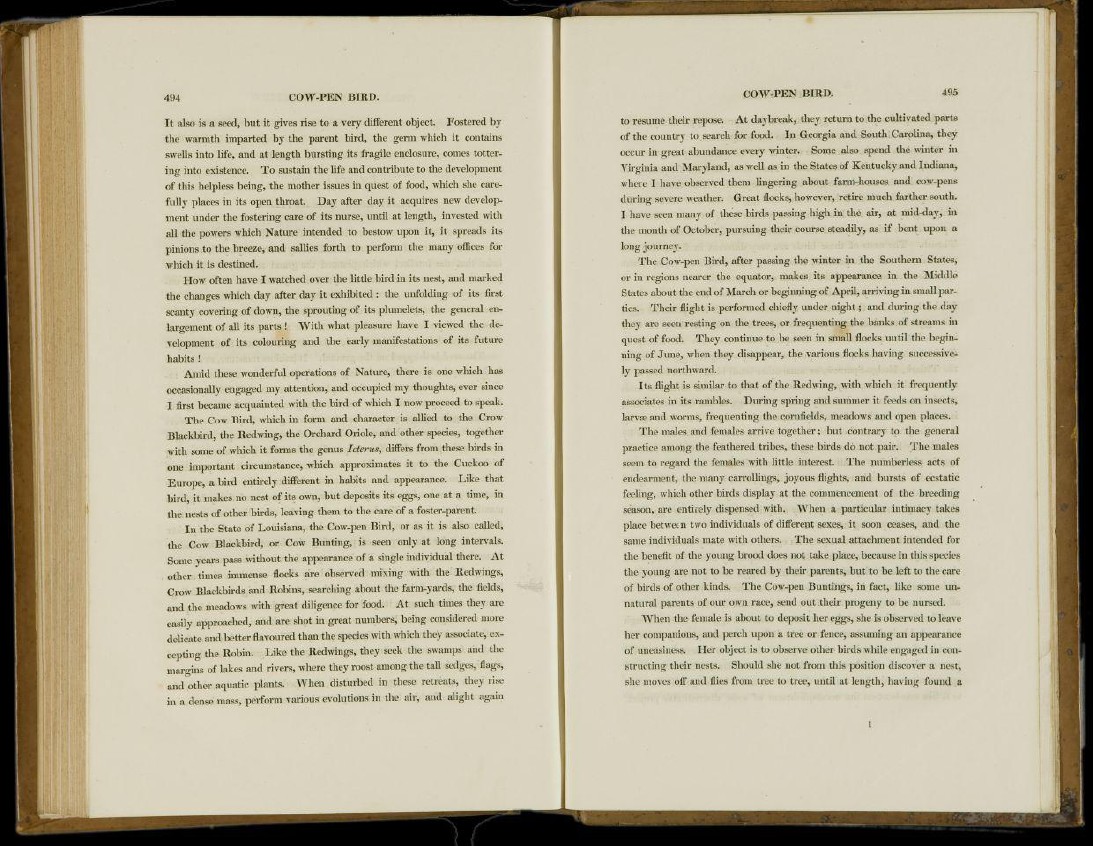
It also is a seed, but it gives rise to a very different object. Fostered by
the warmth imparted by the parent bird, the germ which it contains
swells into life, and at length bursting its fragile enclosure, comes tottering
into existence. To sustain the life and contribute to the development
of this helpless being, the mother issues in quest of food, which she carefully
places in its open throat. Day after day it acquires new development
under the fostering care of its nurse, until at length, invested with
all the powers which Nature intended to bestow upon it, it spreads its
pinions to the breeze, and sallies forth to perform the many offices for
which it is destined.
How often have I watched over the little bird in its nest, and marked
the changes which day after day it exhibited : the unfolding of its first
scanty covering of down, the sprouting of its plumelets, the general enlargement
of all its parts ! With what pleasure have I viewed the development
of its colouring and the early manifestations of its future
habits !
Amid these wonderful operations of Nature, there is one which has
occasionally engaged my attention, and occupied my thoughts, ever since
I first became acquainted with the bird of which I now proceed to speak.
The Cow Bird, which in form and character is allied to the Crow
Blackbird, the Redwing, the Orchard Oriole, and other species, together
with some of which it forms the genus Icterus, differs from these birds in
one important circumstance, which approximates it to the Cuckoo of
Europe, a bird entirely different in habits and appearance. Like that
bird, it makes no nest of its own, but deposits its eggs, one at a time, in
the nests of other birds, leaving them to the care of a foster-parent.
In the State of Louisiana, the Cow-pen Bird, or as it is also called,
the Cow Blackbird, or Cow Bunting, is seen only at long intervals.
Some years pass without the appearance of a single individual there. At
other times immense flocks are observed mixing with the Redwings,
Crow Blackbirds and Robins, searching about the farm-yards, the fields,
and the meadows with great diligence for food. At such times they are
easily approached, and are shot in great numbers, being considered more
delicate and better flavoured than the species with which they associate, excepting
the Robin. Like the Redwings, they seek the swamps and the
margins of lakes and rivers, where they roost among the tall sedges, flags,
and other aquatic plants. When disturbed in these retreats, they rise
in a dense mass, perform various evolutions in the air, and alight again
to resume their repose. At daybreak, they return to the cultivated parts
of the country to search for food. In Georgia and South Carolina, they
occur in great abundance every winter. Some also spend the winter in
Virginia and Maryland, as well as in the States of Kentucky and Indiana,
where I have observed them lingering about farm-houses and cow-pens
during severe weather. Great flocks, however, retire much farther south.
I have seen many of these birds passing high in the air, at mid-day, in
the month of October, pursuing their course steadily, as if bent upon a
long journey.
The Cow-pen Bird, after passing the winter in the Southern States,
or in regions nearer the equator, makes its appearance in the Middle
States about the end of March or beginning of April, arriving in small i^arties.
Their flight is performed chiefly under night; and during the day
they are seen resting on the trees, or frequenting the banks of streams in
quest of food. They continue to be seen in small flocks until the beginning
of June, when they disappear, the various flocks having successively
passed northward.
Its flight is similar to that of the Redwing, with which it frequently
associates in its rambles. During spring and summer it feeds on insects,
larvae and worms, frequenting the cornfields, meadows and open places.
The males and females arrive together; but contrary to the general
practice among the feathered tribes, these birds do not pair. The males
seem to regard the females with little interest. The numberless acts of
endearment, the many carrollings, joyous flights, and bursts of ecstatic
feeling, which other birds display at the commencement of the breeding
season, are entirely dispensed with. When a particular intimacy takes
place between two individuals of different sexes, it soon ceases, and the
same individuals mate with others. The sexual attachment intended for
the benefit of the young brood does not take place, because in this species
the young are not to be reared by their parents, but to be left to the care
of birds of other kinds. The Cow-pen Buntings, in fact, like some unnatural
parents of our own race, send out their progeny to be nursed.
When the female is about to deposit her eggs, she is observed to leave
her companions, and perch upon a tree or fence, assuming an appearance
of uneasiness. Her object is to observe other birds while engaged in constructing
their nests. Should she not from this position discover a nest,
she moves off and flies from tree to tree, until at length, having found a